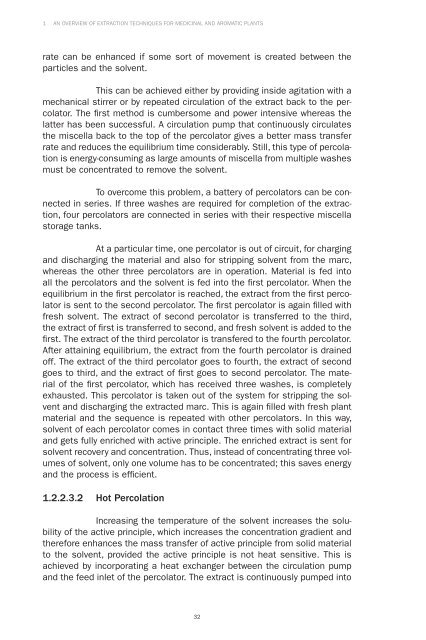Extraction Technologies For Medicinal And Aromatic Plants - Unido
Extraction Technologies For Medicinal And Aromatic Plants - Unido
Extraction Technologies For Medicinal And Aromatic Plants - Unido
Create successful ePaper yourself
Turn your PDF publications into a flip-book with our unique Google optimized e-Paper software.
1 AN OVERVIEW OF EXTRACTION TECHNIQUES FOR MEDICINAL AND AROMATIC PLANTS<br />
rate can be enhanced if some sort of movement is created between the<br />
particles and the solvent.<br />
This can be achieved either by providing inside agitation with a<br />
mechanical stirrer or by repeated circulation of the extract back to the percolator.<br />
The fi rst method is cumbersome and power intensive whereas the<br />
latter has been successful. A circulation pump that continuously circulates<br />
the miscella back to the top of the percolator gives a better mass transfer<br />
rate and reduces the equilibrium time considerably. Still, this type of percolation<br />
is energy-consuming as large amounts of miscella from multiple washes<br />
must be concentrated to remove the solvent.<br />
To overcome this problem, a battery of percolators can be connected<br />
in series. If three washes are required for completion of the extraction,<br />
four percolators are connected in series with their respective miscella<br />
storage tanks.<br />
At a particular time, one percolator is out of circuit, for charging<br />
and discharging the material and also for stripping solvent from the marc,<br />
whereas the other three percolators are in operation. Material is fed into<br />
all the percolators and the solvent is fed into the fi rst percolator. When the<br />
equilibrium in the fi rst percolator is reached, the extract from the fi rst percolator<br />
is sent to the second percolator. The fi rst percolator is again fi lled with<br />
fresh solvent. The extract of second percolator is transferred to the third,<br />
the extract of fi rst is transferred to second, and fresh solvent is added to the<br />
fi rst. The extract of the third percolator is transfered to the fourth percolator.<br />
After attaining equilibrium, the extract from the fourth percolator is drained<br />
off. The extract of the third percolator goes to fourth, the extract of second<br />
goes to third, and the extract of fi rst goes to second percolator. The material<br />
of the fi rst percolator, which has received three washes, is completely<br />
exhausted. This percolator is taken out of the system for stripping the solvent<br />
and discharging the extracted marc. This is again fi lled with fresh plant<br />
material and the sequence is repeated with other percolators. In this way,<br />
solvent of each percolator comes in contact three times with solid material<br />
and gets fully enriched with active principle. The enriched extract is sent for<br />
solvent recovery and concentration. Thus, instead of concentrating three volumes<br />
of solvent, only one volume has to be concentrated; this saves energy<br />
and the process is effi cient.<br />
1.2.2.3.2 Hot Percolation<br />
Increasing the temperature of the solvent increases the solubility<br />
of the active principle, which increases the concentration gradient and<br />
therefore enhances the mass transfer of active principle from solid material<br />
to the solvent, provided the active principle is not heat sensitive. This is<br />
achieved by incorporating a heat exchanger between the circulation pump<br />
and the feed inlet of the percolator. The extract is continuously pumped into<br />
32

















